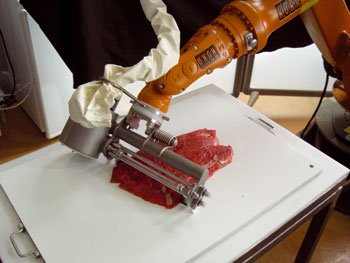
Just an unusual image I ran across in the Journal of the Centre Nationale de Recherche Scientifique (CNRS), in an article entitled “The Robot Butcher” (I can’t make these things up).
Why have a robot cut meat? Efficiency, it seems: the do-dad above can prep 250 kilograms of meat per hour versus the 100 kilograms per hour by its human competitor. And it does so with a smaller margin of error. No way to get a little extra from the butcher anymore. No special cut. And no one to flirt with, either (I’m thinking of Alice on the Brady Bunch here).
The oddness of the image, however, lies in the striking contrast between the mechanized butcher and the all-too fleshy substance of the meat. Somehow, it seems unfair to the cow, and moreover, seems like an intrusion of the mechanical into an utterly animalistic behavior—namely the consumption of one critter by another.
Hrm. Anyway…
There’s a kinda interesting diagram of the Sun, too, but I found the robot butcher more engaging, for whatever reason.




